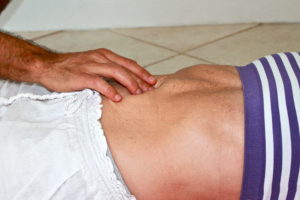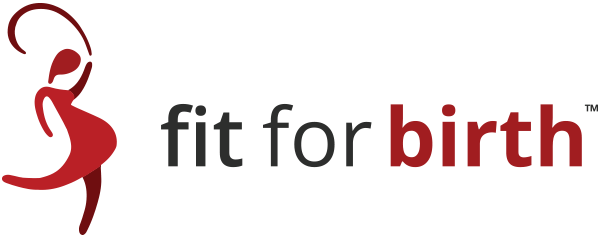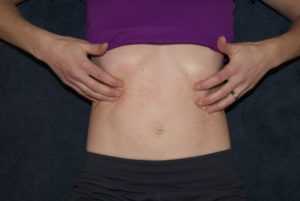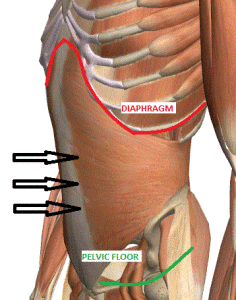 Fitness professionals have a unique opportunity to either heal or further worsen Diastasis Recti in their pregnant or postpartum clients. Although “core” is now a staple fitness topic of the new century, appropriate application in fitness arenas can be lacking. Lack of knowledge about deep core inner unit mechanics often means exercises that are classically referred to as “core exercises” often don’t work the core at all.
Fitness professionals have a unique opportunity to either heal or further worsen Diastasis Recti in their pregnant or postpartum clients. Although “core” is now a staple fitness topic of the new century, appropriate application in fitness arenas can be lacking. Lack of knowledge about deep core inner unit mechanics often means exercises that are classically referred to as “core exercises” often don’t work the core at all.
The transverse abdominis (TVA) receives most of the press when it comes to inner unit core function, so the “draw-in” cue runs rampant in fitness classes all over the world. However other muscles like the diaphragm (DPH), pelvic floor (PF), and multifidus are also known as primary “inner unit” components. What if these were just as responsible for optimal core function, and for preventing or healing diastasis recti?
Here, we will look at three common mistakes made by fitness professionals that permit or outright cause Diastasis Recti in their perinatal clients.
- General Lack of Core Cueing
- Lack of DPH Cueing
- Over-Cuing the TVA
General Lack of Core Cueing
 Core Exercises that Don’t Improve the Core?
Core Exercises that Don’t Improve the Core?
Sometimes trainers unknowingly allow their clients’ existing (dysfunctional) inner core mechanics to persist in the midst of their selection of “core exercises.” For example, if a pre or postnatal client is doing a side-plank, a bird-dog or any balancing/stabilizing core exercise while holding their breath, should that count as a core exercise? More specifically, if our client’s DPH is not actively contracting and relaxing through a full range of motion during the exercise, can we legitimately say that she is achieving proper core activation? What if the PF is under-activated, or completely off while the exercise is being performed? Would that exercise still count as achieving proper core activation?
The short answer is, “NO.” An exercise that does not allow for the core’s inner unit to function in a dynamic harmony cannot fully count as an exercise that improves core function. Maybe that exercise is burning calories and maybe it’s fatiguing the rectus abdominus, but it is not improving true inner unit core function.
An example of this is a side plank where the client’s DPH is not contracting fluidly, her TVA is out, and her PF is off. Yet she is able to stay in the position for 60 seconds. What has she just improved? In this case, she has improved her leg strength (like lateral quads, TFL, and maybe glute medius) her obliques, and her shoulder lock. But she hasn’t improved the function of the inner unit of her core. In other words, just being in the position does not guarantee good core function.
This means that on the traditional fitness floor, a client who thinks she is performing “core exercises” is often actually not. While the client may improve in many gross tests of strength, speed, reps, time and other general fitness skills, she is actually improving in compensatory areas instead of proper inner core mechanics. She is upholding certain fitness criteria despite true core function.
Women who train like this, regardless of whether or not they have a fitness professional by their side, are at risk of diastasis recti.
Lack of Diaphragm (DPH) Cueing
A Program Repeated is a Program Reinforced
If you want to make sure that your client is not causing or worsening her diastasis recti, you’ll have to practice seeing and cueing proper core breathing mechanics as she exercises.
Lack of DPH breathing creates a rigidity in the prenatal midsection that leaves the TVA and PF stagnant which ultimately prevents them from activating appropriately. DPH movement stimulates the PF to mirror its action. Both muscles stimulate the TVA to react. Outside of those rare times that a maximal physical effort and valsalva bracing of the breath is necessary (ie. olympic powerlifting and emergency situations), maintaining some version of core breathing (with fluid DPH activation) is more beneficial for overall function, and therefore preventing diastasis.
Every repetition, and every moment, that DPH function is under-active, is a moment where sub-optimal core function occurs. A program repeated is a program reinforced. Not only does an underactive DPH wreak massive havoc in bodily systems as widespread as immunity and hormonal, but for some women the DPH is more important than the TVA in preventing diastasis recti.
We trainers still largely operate within the energy that birthed our industry: “no pain, no gain.” Rather than thoroughly coaching diaphragmatic breathing, we tend to push our clients to the max, burning calories, and overall generating a “great workout” as the basis of our personal training sessions. And there is nothing inherently wrong with this approach. It’s just that this often reinforces our clients’ pre-existing dominances.
Trainers that wish to coach outside this traditional fitness paradigm will have to learn to prioritize proper inner unit muscle activation over traditional fitness skills. In this case, you’ll have to coach DPH breathing where the belly and ribs remain active in the midst of the exercise. Essentially, you’ll have to be open to learning a new way of cueing the core, one that the fitness industry is not yet regularly promoting.
Muscle Programs are Written on Every Repetition
To make this point really clear, let’s look at a similar scenario as it often plays out in leg exercises. First, we know that most of our clients are quad (knee joint) dominant when squatting. And most trainers know to teach them how to activate their glutes (hip joint) instead. Once we know that our client can activate their glutes, we are more likely to add weight, encourage them to do more reps, and otherwise “push them to the max” because we are aware that loading their glutes will save their knees. As this is occurring in the midst of our training session, we are vigilant that at some point, at some weight, our client will slip back into their quad dominance. Now, if our primary focus is for our clients to activate the correct (glute) muscles, we will immediately tell them to slow down and coach them back to glute loading, or have them stop the exercise. If on the other hand, the primary focus is burning calories or lifting the weight a certain number of times, the trainer would allow the client slip back into quad loading on the last few reps.
Technically, each compensatory quad over-activation in the example above is programming a lesser functional response into the neuro-muscular system. Worse, it has been thought that the final reps (done poorly) can over-write the program for the previous ones because the most challenging reps are most likely to be etched into muscle memory (much like a traumatic experience is more likely to be remembered by the nervous system). This could mean that a quad loaded final 10th rep may overshadow the first nine reps of a glute load, thereby etching the compensatory pattern far more than expected.
In the same manner, a client’s optimal diaphragmatic breathing or inner core synergy can slip back into the dysfunction zone at any time. This is especially true once they begin to get further challenged in the exercise. Once their core breathing stops or is just sputtering in the midst of their 60 second side-plank, it must be recognized that the client is now improving muscle adaptations in her arms, legs, and obliques, but not necessarily the DPH, TVA, and PF.
Essentially, enough stress in exercise or life reverts our clients to their pre-existing dominant muscle programs. Once the threshold for the weakest point in the chain is passed, poor function can literally happen on every repetition. The trick for the fitness professional is to recognize when that line is about to be crossed, and regress or stop the exercise before allowing the client to activate sub-optimal inner unit patterns. This is a primary difference between pre and postnatal corrective exercise and the usual personal training.
Over Cueing the TVA
The “Draw-In” Cue Can De-Activate the DPH
For any client, pregnant or not, well-intentioned TVA cues to “draw-in” can disrupt foundational inner unit mechanics of the DPH. To be sure, “drawing-in” is a fantastic answer to a big problem, so long as the problem is that the TVA doesn’t concentrically contract in a functional manner (which is indeed the case in most people). “Drawing-in” is a great cue for reminding your clients to generate TVA contraction especially if it doesn’t hinder DPH contraction.
The core inner unit system is a pump. During the inhale, the DPH contracts concentrically, pushing into and massaging the abdominal contents. While this is happening, the TVA would naturally relax (if the client is not experiencing a physical demand) or eccentrically expand (if the client is in the middle of an exercise). During the exhale, the DPH simply relaxes back into start position (if the client is at rest) while the TVA may concentrically contract (if the client is in the midst of an exercise or other physical demand).
The problem occurs when fitness enthusiasts start to activate the TVA “draw-in” so often that they are directly hindering the DPH from contracting. Worse is when the client adopts this new fitness pattern into her activities of daily life. The big stinker is that a restricted DPH will often have far more profound and far-reaching effects. At the very least, the DPH muscle is higher on the totem pole than the TVA.
The point to make clear is that contracting one’s TVA all day long (or in excess during a personal training session) can directly hinder the DPH from contracting deeply and properly. Diaphragmatic weakness not only hinders one’s ability to exchange oxygen for carbon dioxide and other wastes, but it causes a system-wide emergency stress response for the entire body. Multiple pump mechanisms are worsened; energy is exhausted, and muscle alignment mechanics are derailed. This causes other tightness and weaknesses up and down the kinetic chain, ultimately making a person who may be strong in the TVA suffer from many other seemingly unrelated maladies.
Ironically, if left to ingrain long enough, this scenario of under-active DPH and over-active TVA ultimately results in a weak core.
Draw-In Cue May Cause Diastasis in Rare Cases
Sometimes, fitness professionals who over-cue the draw-in technique unwittingly set their clients up for an unusual emergence of diastasis recti. Much of the fitness world has been conditioned for TVA holding (rather than some version of cyclic core breathing or belly pumping). Fitness enthusiast clients who are taught to hold their TVA excessively and who then become pregnant and continue over-activating their TVA are at risk.
This emerging breed of fitness enthusiasts are often proud of their tight abdominal muscles while unknowingly losing their ability to activate their DPH. Unfortunately, they are setting themselves up for a battle with their uterus. Pregnancy means that their uterus grows slowly day-by-day, but their fitness mentality keeps the mom-to-be over activating their abdomen. The baby keeps growing, but she keeps holding her ab muscles tight. People are often impressed when the client is entering the third trimester, yet looks like “she’s hardly showing.” Finally, she delivers her baby, only to discover that she’s got a 3 or 4 finger-width diastasis. She can’t believe it because she trained her core, and she felt so strong and sure of herself. Now she’s got a tummy that she’s no longer proud of; what is going on?!
In cases like these, it is a battle that the growing uterus will ultimately win. The woman does such a good job of holding her TVA muscles tight that the only place for the uterus to expand was right through the linea alba. In this case, the abdominal muscles were holding tighter than the linea alba could withstand. But the baby had to grow, and if mom’s overly active muscles weren’t going to allow for expansion, then the body would have to create that space by moving through whatever tissue would allow growth—in this case, the connective tissue between the rectus abdominis.
A Core Breathing Solution for Diastasis Recti
As is so often the answer, balance is the key. Our clients need both expansion and contraction, both tightness and relaxation in the muscles. And that’s why a concept like Core Breathing Belly Pump™ is such a great tool. It is defined by Fit For Birth as “Rhythmic inhaling and exhaling that maintains activations of the DPH, TVA and PF to dynamically maintain intra-abdominal pressure so that the inner unit may assist in stabilizing, accelerating, and decelerating any movement or exercise.” Teaching your prenatal clients to maintain their natural core pump mechanics during both the inhale and exhale phases of breathing keeps a strong active core and prevents diastasis.


